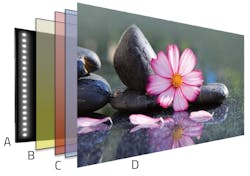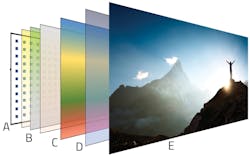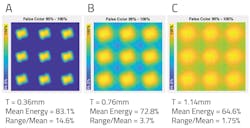Driven by innovations in 2D mini-LED backlight architecture, liquid-crystal display (LCD) designs now demonstrate similar contrast performance to emissive displays, including organic light-emitting diode (OLED) displays, with contrast ratios on the order of 1 million to 1. They also achieve continuous and peak brightness levels exceeding 1,000 nits, depending on the display model, without the potential of burn-in, which often plagues OLED devices. These increases in contrast and brightness are driving improvements across multiple electronic devices.
While the benefits are promising, challenges remain in creating a uniform 2D mini-LED backlight that meets thickness and efficiency demands. This article discusses backlight design considerations and how micro lens array (MLA) technology improves this new architecture.
Up for the challenge
In assessing designs for a new 2D mini-LED backlight, engineers should first acknowledge the ways it differs from a traditional LCD backlight. Typical LCD backlights in the market consist of a row of LEDs, aligned along one edge of the backlight unit, that are directed into a light guide. These edge-lit displays generally rely on a single diffuser film in conjunction with crossed brightness enhancement films (xBEFs) to manage and direct the light to the user (Fig. 1). The diffuser film (down diffuser) ensures smooth, uniform light output from the light guide, while the xBEFs narrow the viewing angle of emitted light and increase its intensity outward. Though they are a mature, cost-effective technology, edge-lit LCDs are unable to create high dynamic-range (HDR), high-contrast content like OLED displays and cannot efficiently reach brightness levels that customers demand.
Two-dimensional mini-LED backlight units (2D BLUs) consist of an array of LEDs bonded to a PCB that turn on and off or adjust to a specific brightness, individually or in clusters of a few LEDs. Depending on the design, local dimming zones, numbering from the hundreds to the thousands, solve an inherent drawback that limits an LCD’s contrast performance. An individual liquid-crystal cell in the panel acts as an on/off switch. But this switch is unable to fully turn off, thus allowing light to leak through. Consequently, dark colors and blacks are not well reproduced, resulting in a relatively low contrast ratio.
To circumvent the light leak issue, 2D BLUs dim or turn off specific zones in the backlight, so little to no light remains to leak through when the liquid crystal cell is off. This reproduces truer blacks and dark colors, dramatically increasing the contrast ratio.
In a 2D BLU, each individual LED in the array acts as a light point source that must be hidden or smoothed out to produce uniform light output. The display must also be thin and energy efficient for mobile devices, such as smartphones, tablets, notebook computers, and displays in electric vehicles. 2D BLUs often use lower-cost, widely available blue LEDs, which require a film to create white light by converting some blue light to red and green for the LCD to work properly. Figure 2 shows an example film stack configuration in a 2D BLU. The LED array is located at the back of the stack, followed by the films used for LED hiding, the color conversion film, xBEFs, and the LCD panel.
The new architecture offers exciting opportunities for display designs but requires a departure from current diffuser film methods for LED hiding.
Design factors for 2D BLUs
Several factors and tradeoffs should be considered during the design process when creating a high-performance 2D BLU display.
Spacing or pitch: 2D BLUs arrange LEDs in regular square matrix arrays or in checkerboard patterns. The LEDs can be spaced differently, depending on the design. Using fewer LEDs reduces costs, but the result does not perform as well as using more LEDs in backlights.
LED Type: LEDs can have a distributed Bragg reflector (DBR) that directs light to the side of the LED, as opposed to in a Lambertian distribution (non-DBR). A reflector can also be used behind the LED array to help direct and recycle light out. It can consist of different materials and reflective properties, which affect the performance of the films in the stack.
Packaging and encapsulation: LED arrays use a bare die and are encapsulated directly onto the PCB versus the traditional packaged LED format. LED packaging methods can influence hiding performance.
Color: Blue LEDs are often used for the backlight, but white LEDs (in chip-scale packages) have also found use. Blue LEDs require a color-conversion film; white LEDs do not. The two types of color conversion film available today are quantum dot and phosphor.
Color edge mura: 2D mini-LED displays can exhibit color nonuniformity around the display perimeter, which affects image and video color quality. A film or software can correct it, which is critical as LCD developers move to bezel-less displays.
BLT: Blue layer transmission films enhance transmission of blue light from the LED array and reflection of red and green from the color-conversion film. This adds cost and thickness to the backlight but offers a performance boost.
Thickness: The thickness of the display depends on the design of the BLU and can be a function of the LED spacing, type, and encapsulation, among other factors.
Cost: Perhaps the most important consideration, the cost of a 2D BLU display depends on several factor, including the number of LEDs, type of LED (blue or white, DBR versus non-DBR), thickness, film choice, encapsulation, and rigid or flex PCBs.
The components of a BLU are interdependent: Changing one component can have meaningful performance and cost impacts on others. The design must factor in component interdependencies to determine which LED hiding solution is optimal. Due to the sheer number of design combinations, every 2D BLU requires some level of film stack customization.
LED hiding with conventional volumetric diffusers
Edge-lit LCDs may rely on volumetric diffusers or simple coated diffusers (coating on a film) as the down diffuser to create a uniform backlight. Volumetric diffusers can work well in edge-lit displays and are widely used in LED lighting for hiding. However, they are not well suited for 2D BLU applications because they cannot create the acceptable light uniformity or meet stringent performance requirements — primarily thickness and efficiency — to take full advantage of the new architecture.
A strongly scattering, thick volumetric diffuser is required to sufficiently hide LEDs in a 2D BLU. If the volumetric is too thin, mura appears, which manifests as uneven luminance across the display, and individual LEDs remain visibly distinct. Figure 3 shows the results of LED hiding performance using a 105° volumetric diffuser with three different thicknesses. The volumetric film was placed directly on the LED board followed by the color conversion film and xBEFs. With a 0.36-mm film (left), the LEDs are clearly visible with a range/mean (brightest point versus dimmest point) of 14.6%. As the thickness increases to 1.14 mm (right), the range/mean is reduced to a more acceptable level of 1.75%. However, the mean energy (brightness) is reduced to 64.6%, an efficiency level unacceptable for most 2D BLU design specifications.
Note that measurements are highly dependent on the mini-LED board configuration and design. Measurement values are relative and used for direct comparison purposes only.
As mentioned earlier, 2D BLUs arrange LEDs in a square or rectangular array. However, volumetric films diffuse light radially, which can create hot spots due to overspreading. As the volumetric film thickness is increased to create sufficient hiding, light from adjacent LEDs begins to overlap, making an optimal, homogeneous light spreading configuration challenging.
LED hiding with micro lens arrays
Micro lens arrays use customized engineered optics to steer and shape light in a various applications, and they can be engineered to hide LEDs in 2D BLUs more effectively than volumetric diffusers. MLAs feature micron-scale lenses that are embossed, etched, or molded onto or in optically clear substrates such as polyethylene terephthalate (PET) and polycarbonate films. BrightView's MLAs are manufactured in a high-volume, roll-to-roll production process, which uses an embossing tool created on a digital, gray-scale lithography system. The resulting lens design can be tailored to efficiently hide the 2D LED array with high uniformity and zero optical distance. MLAs achieve this using three methods: beam shaping, image splitting, and film thickness.
MLAs can create distinct beam shapes, in effect reversing an LED’s emission profile, to steer the zero-order emission into the dark regions between LEDs. For example, a Lambertian LED source can be shaped into various intensity profiles with different symmetries using specific lens shapes tailored to match the geometry of a 2D LED array. Figure 4 shows example beam shapes made possible using MLAs.
Image splitting takes a single LED and splits the profile to simulate multiple points of light so a single LED acts as multiple sources that are closer together, achieving higher LED packing density optically. The lens shape of the MLA determines how the light is split.
As with volumetric films, thickness plays a role in optimizing LED light spreading and hiding. Beam spread increases proportional to the film thickness. Thus, choosing the proper film thickness to avoid over or under spreading, which can create hot spots, is important. In general, LED arrays with a larger pitch require thicker films.
Many film stack configurations are possible depending on the 2D BLU design. In one example, a stack of three MLAs situated on top of the LED array hides the LED point sources and creates uniform light output, followed by a color conversion film, xBEFs, and LCD panel. In some cases, the color conversion film is placed directly above the LEDs followed by the MLA film stack, and a BLT may be added. Microstructures can also be patterned directly on the color conversion film for added functionality.
Volumetric versus MLA films
By making use of beam shaping and image splitting, MLAs can improve the LED hiding performance in 2D BLUs when compared to conventional volumetric diffusers. Figure 5 shows results of a direct comparison between a BrightView MLA stack and volumetric diffusers of different thicknesses. A 0.76-mm-thick volumetric diffuser had a mean energy of approximately 73% (left). However, the range/mean was high at 3.7%; the individual LEDs are easily distinguished in the image. In the center sample, the volumetric film thickness was increased to 1.14 mm and the range/mean improved to 1.75%, indicating good hiding. The mean energy dropped to 64.6%, which is below the acceptable value for efficiency. Compare these results to a third MLA film stack (right). At 0.6 mm, the mean energy is 73.4% and the range/mean is 1.67%, demonstrating that an MLA film stack can outperform a volumetric diffuser in both LED hiding and efficiency performance while maintaining a thin stack.
Conclusion
2D BLUs now allow LCDs to compete with OLED displays in contrast ratio without burn-in, and they can generate higher peak and sustained brightness levels. The 2D BLU architecture presents several new challenges in creating a highly uniform backlight that is thin, efficient, and cost effective. MLA technology addresses these challenges through more sophisticated and controllable use of light management, as compared to conventional volumetric diffusers, and ensures that a new BLU reaches its full potential.
*BrightView Technologies develops and supplies optical technologies such as those described in this article.
Get to know our expert
BENJAMIN JACOBS is engineering program manager at BrightView Technologies, an optical solutions company located in Durham, N.C., where he has been in product marketing and engineering management roles for nearly three years. Jacobs received a Ph.D. in engineering from Michigan State University and worked as a postdoctoral appointee at Sandia National Laboratories in the energy nanomaterials department. During his near-decade at nanotechnology research firm ProtoChips, he developed application notes and customer support materials, as well as presentations for business development; he also introduced new products and software.









